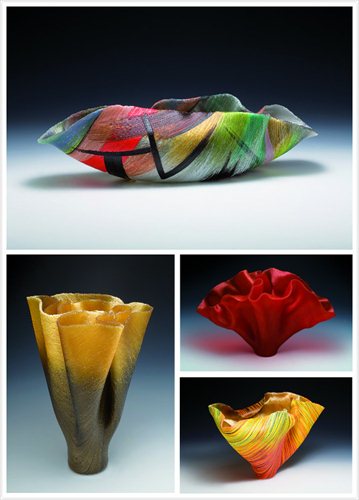Following the threads
US glass artist Toots Zynsky’s adventures with hot glass
"Glass is but sand. But because of Toots Zynsky, it has gained a newfound light and color," said Chang Yi, a Taiwanese glass artist.
Over the past three decades, US studio glass master Toots Zynsky (pictured below), born as Mary Ann, has invented and used the technique known as "filet de verre" (layers of glass threads) to make multi-colored glass artworks that have been collected by 70 museums and other institutions around the world, including the Museum of Modern Art and the White House.
Each of her works uses thousands of glass threads of varying colors and lengths, which are arranged on a board then fused in an oven. Zynsky then shapes them into vessels by hand.
Her works are so striking that US art critic Arthur C. Danto said "Zynsky's work is uncompromisingly beautiful. It is however what the poet André Breton would have called convulsive beauty."
Recently, Zynsky has paid her first visit to China and brought more than 20 pieces for her debut solo exhibition in China, Dance of the Aurora, at Liuli China Museum (25 Taikang Road, 6467-2268). The show lasts until June 1.

Move, move
Born in 1951 in Boston, Zynsky has an almost innate fondness for handicrafts and the beauty of lines. Her family kept delicately woven items passed down the generations, and she started to collect Chinese baskets at a very young age.
In 1971, Zynsky entered Rhode Island School of Design. But at the end of the first year's general course, she was on the edge to quit because she didn't find anything interesting. She decided to see the entire campus before she left.
That's when she encountered a new building that didn't even exist on the campus map, but which completely changed her life.
"There was this wild music playing and people were running. Out of the door, I could hear the roar but I didn't have any ideas of what it was," Zynsky told the Global Times.
"Everyone was in some crazy costume, and they were making a film, and I looked in the door, and there was hot glass swirling through the air, and I was completely captivated by it."
The ceaselessly moving crowd made Zynsky believe that she belonged, because for her - a music lover who had studied piano for 11 years and always yearned to dance - these people moved in their work as if they were dancing.
"When I hear music, it translates into color," said Zynsky, who revealed that she has a "funny taste" in music that ranges from ancient tribe music to The Rolling Stones, Jimi Hendrix and rap.
All the artworks for the Shanghai exhibition were created while she was immersed in all sorts of different kinds of music.

US studio glass artist Toots Zynsky's multi-colored glass artworks have been collected by 70 museums and other institutions around the world. Photos: Courtesy of Toots Zynsky and Liuli China Museum
Experimental workaholic
At Rhode, Zynsky mastered techniques of blowing, fusing, casting and slumping heated glass with glass master Dale Chihuly, with whom she also set up a new school on the West Coast.
Meanwhile, she kept experimenting with new methods, and in 1982 she created the special method of hot-fusing glass threads, which she dubbed "filet de verre."
At the beginning, she had to employ two teams of people to pull thread for her all day. Eventually, with the help of Dutch technician Mathijs Teunissen Van Manen, she built a machine that made the mass production of glass thread possible.
Zynsky spent 16 years in Europe before she returned to the US in 1999 with her family to settle in Providence, Rhode Island, where she lives and works today.
It took about half a year for her to prepare for the Shanghai exhibition, during which time she became a workaholic to meet the deadline.
"I worked for months and months, 15 hours a day, seven days a week. My husband forgot almost that he had a wife. But I did make sure that every day I had dinner with him, and that's the limit!" laughed Zynsky, who admitted that she loved working hard and focused because it made her feel more deeply involved in her craft.
"It's like training for the Olympics. You go to bed on time, you have to eat carefully, you can't have too many coffees in a day, you have to be careful about eating on time and going to sleep on time, getting 8 hours of sleep at night," said Zynsky.
Artistic block
Amid busy exhibition schedules, Zynsky also likes to draw and travel to different continents to refresh her mind.
She had never encountered artistic block until she lost eight relatives in a 2-year period.
"All the death was just paralyzing. For a while I just couldn't work at all. I even thought maybe I'm done," recalled the artist.
"I would look at my own work, and I had no relationship, like when you meet a stranger. I didn't know why I'd made it, and had no inspiration to keep making it. I looked at all the colors, they didn't mean things to me."
Even music didn't pulled her out of her sorrow. But one day, her son persuaded her to make a new piece.
"When I finished it and took it out of the kiln and put it in the sunlight, it made me very happy, and that's when I started to work again," said Zynsky.
For Zynsky, the color of the piece - red - is the first color we see in the world as an infant through our eyelids; it is also the color of blood, and the color that grabs one's attention the most quickly.
"I think the complexity of life is very much like the complexity of glass, sometimes it's very harsh, sometimes it's serenely beautiful and sometimes it's just murky and doesn't work," Zynsky told the Global Times.